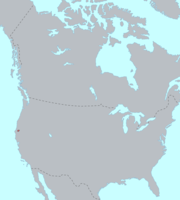
Chimariko
Encyclopedia

Trinity River (California)
The Trinity River is the longest tributary of the Klamath River, approximately long, in northwestern California in the United States. It drains an area of the Coast Ranges, including the southern Klamath Mountains, northwest of the Sacramento Valley...
in Trinity County
Trinity County, California
Trinity County is a large, rugged and mountainous, heavily forested county located in the northwestern portion of the U.S. state of California, along the Trinity River and within the Salmon/Klamath Mountains. It covers an area of over two million acres , and as of the 2010 census its population...
in northwestern California
California
California is a state located on the West Coast of the United States. It is by far the most populous U.S. state, and the third-largest by land area...
.
The Chimariko were profoundly affected by the destructive practices of gold seekers during California Gold Rush
California Gold Rush
The California Gold Rush began on January 24, 1848, when gold was found by James W. Marshall at Sutter's Mill in Coloma, California. The first to hear confirmed information of the gold rush were the people in Oregon, the Sandwich Islands , and Latin America, who were the first to start flocking to...
(during the 1850s). One of the major issues involved the disruption of the salmon
Salmon
Salmon is the common name for several species of fish in the family Salmonidae. Several other fish in the same family are called trout; the difference is often said to be that salmon migrate and trout are resident, but this distinction does not strictly hold true...
population that was the main food source of the Chimariko. In the 1860s, conflict between Chimariko and white miners led to almost total extinction of the entire population. The surviving Chimariko fled to live with the Hupa
Hupa
Hupa, also spelled Hoopa, are a Native American tribe in northwestern California. Their autonym is Natinixwe, also spelled Natinookwa, meaning "People of the Place Where the Trails Return." The majority of the tribe is enrolled in the federally recognized Hoopa Valley Tribe; however, some Hupa are...
and Shasta
Shasta (tribe)
The Shasta are an indigenous people of Northern California and Southern Oregon in the United States. They spoke one of the Shastan languages....
. The Chimariko language
Chimariko language
Chimariko is an extinct language isolate formerly spoken in Trinity County in northwestern California by Chimariko peoples.-Genetic relations:...
probably became extinct sometime in the 1930s. It is extensively documented in unpublished fieldnotes which John Peabody Harrington
John Peabody Harrington
John Peabody Harrington was an American linguist and ethnologist and a specialist in the native peoples of California. Harrington is noted for the massive volume of his documentary output, most of which has remained unpublished: the shelf space in the Library of Congress dedicated to his work...
obtained from the last speaker, Sally Noble
Sally Noble
Sally Noble was the last speaker of the Chimariko language. She worked with linguist and ethnologist J.P. Harrington to record what she remembered of the language. ....
, in the 1920's.
Population
Estimates for the pre-contact populations of most native groups in California have varied substantially. (See Population of Native CaliforniaPopulation of Native California
Estimates of the Native Californian population have varied substantially, both with respect to California's pre-contact count and for changes during subsequent periods. Pre-contact estimates range from 133,000 to 705,000 with some recent scholars concluding that these estimates are low...
.) Alfred L. Kroeber
Alfred L. Kroeber
Alfred Louis Kroeber was an American anthropologist. He was the first professor appointed to the Department of Anthropology at the University of California, Berkeley, and played an integral role in the early days of its Museum of Anthropology, where he served as director from 1909 through...
(1925:109, 883) proposed that the 1770 population of the Chimariko, together with the New River, Konomihu, and Okwanuchu groups of the Shasta, had been about 1,000. Specifically for the Chimariko, he estimated an 1849 population of 250. Shirley Silver (1978:205) put the aboriginal population at "only a few hundred".

